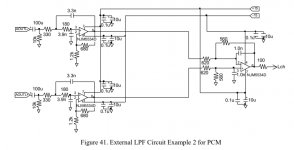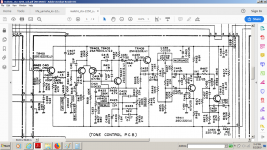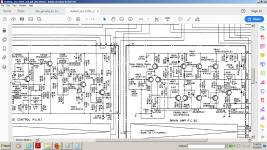+1In this game its more important to specialize in a particular topology, refine it over time and become expert in using it.
The fact is some folks like VFA and some CFA . . . leave it at that.
Everybody have his own preferences, Why the hell, want to impose them on others?
This hate for CFA is the strangest thing I have seen in the audio world. I notice that the ones who like, design, and use them, don't have anything against VFAs.
More than this, they have, for most of them, designed, used and liked many VFAs amps.
Who is closed minded or religious ?
Last edited:
look at the AKM datasheet, figure 41, that is a recommended circuit...
The one attached below?
Except for the coupling caps right out of the dac chip, the caps I see in the audio path would probably be termed filter caps, typically NPO or C0G types. Maybe film caps in some implementations. Don't see electrolytic coupling caps like that for ESS chips, nor will AK4499 use them.
Attachments
Last edited:
Yes, those are the coupling caps I was referring to. If outward appearances are not misguiding, renowned brands like RME use AKM DAC thusly.
Of course they have Bratwurst in their ears and only rely on measurements....still, one of the highest regarded professional/studio brands. That was actually the point I was trying to make. Use a coupling cap when it makes sense.
Of course they have Bratwurst in their ears and only rely on measurements....still, one of the highest regarded professional/studio brands. That was actually the point I was trying to make. Use a coupling cap when it makes sense.
Last edited:
Sorry, you don't get my point, or rather, Bruno's.
Specs are how the design object is supposed to be performing. By positing it should be current feedback, you are excluding possible solutions that might be better than CF from the outset. A true engineers nightmare.
OK Good. This allows me to give more details about the creative process; This was NOT a product or design developed to meet a spec or customer need/interfacing.
My experimental design was multi faceted.... first, to make a direct-coupled design to eliminate coupling and the gain/fb capacitors. And, I had only heard circuits with high gnfb or tube designs with low gnfb and so i wanted to 'hear' an inherently linear solid state circuit withOUT high gnfb to see what difference, if any, it would have.... audibly and measured. The parameters set for my curiosity led to a circuit behaviour that is now known or called CMA.
In fact, during our conversation, after my publication, with engineers at Comlinear and Elantec, I was asked by them why I used this topology in a line stage and not in the phono stages. I told them, it was only because the line stage was developed last. Had I started with the line stage and this topology for the line stage, I would have used it for the phono stage as it was a superior performer.
THx-RNMarsh
Last edited:
(but don't interpret this as agreement with your covariance idea or brand attachment, equally nonsensical as an abhorrence of caps in the signal line IMO.)
JC 's input filter had a very small time constant compared with an input capacitor into the impedance of a fet or valve gate-grid resistor...where the transistor internal capacitance(in series with the input capacitor) dominates the final product....Covariance functions
It's just an idea...i'm not a mathematician!!!don't judge me if i got it all wrong just out of enthusiasm!
.
In QSC amplifiers we have a different story, where the speaker's impedance becomes significant in relationship to the coupling capacitors, but the speaker is no capacitor...
So you are right! I was just enthusiast about some unnecessary magic potion.The laws of physics never betray me, it's just that they flirt a lot in my head with too many random unknown ideas.
Last edited:
About Bruno, i think he is one of the best engineer in this domain.
His Class D amps are among, if not THE best class D amps on the market. As well as his SMPS.
Not at all the best amp you could find, in full range, when you compare with some more classical others.
No, used correctly (as with any amp) they are among the very best there are, with very, very few competitors.
As long as you don't peek, of course... 🙂
I hope you're not serious about it...Medical equipment is usually way higher class than the most high end audio equipment as it is about saving lives.Telecom equipment has way stricter rules than audio too.Come on Vacuphile. This is audio - not some industrial, medical or telecoms application that may need some serious tradeoffs or performance must have's.
In this game its more important to specialize in a particular topology, refine it over time and become expert in using it.
The fact is some folks like VFA and some CFA . . . leave it at that.
🙂
For those who prefer to enjoy the distortion of their drivers as pristine as possible. 🙂... they are among the very best there are, with very, very few competitors...
Well, yes... Layers of onion, peel away one and then deal with the next worst problem...
The digital source is hard to improve, as is the dac, amp... So - the real area to improve is speaker and room... Like JN was discussing... 🙂
The digital source is hard to improve, as is the dac, amp... So - the real area to improve is speaker and room... Like JN was discussing... 🙂
🙂...
The digital source is hard to improve, as is the dac, amp... So - the real area to improve is speaker and room...
0
Mark, you are right, one should not bus through Indochina and post on a mobile after having a beer or two.I was generalizing from a AK4490 board I worked on.
Can't link, but if you look at the AKM datasheet, figure 41, that is a recommended circuit.
Many implementations outside of the eval board don't use the caps, it's really only if you can't get rid of the common mode DC with a diff amp. But your point stands, that the evaluation board does use the caps and achieves very good measured results with them.
Use a coupling cap when it makes sense.
What never ceases to amaze me is that in the 70's when folks were still using 741's and building quasi-complementary PA's with power transistors that barely had 2MHz ft, some focused on the "sound" of coupling caps.
🙄 I've heard that before. Often those who claim that turned out not to be serious because their later responses to certain forum members contradicted the claim.Thx JC, he's already in my ignore list 🙂 🙂 🙂
Because they already are at excellent sounding level even at low price.The digital source is hard to improve, as is the dac, amp...
But the believers will do thisSo - the real area to improve is speaker and room... Like JN was discussing... 🙂
An externally hosted image should be here but it was not working when we last tested it.
and continue on with their digital chase.
....due to the little blue pill....
Well I had to take the red pill to be able to marry mine!
I hope you're not serious about it...Medical equipment is usually way higher class than the most high end audio equipment as it is about saving lives.Telecom equipment has way stricter rules than audio too.
We are in agreement - you have misread my post.
Let me repeat it differently: this is only audio. Relax about the caps. As long as you follow the basic rules, they are way down on the pareto of potential problems you have to deal with in audio.
An externally hosted image should be here but it was not working when we last tested it.
Typically the way some listen to music or amplifiers-speakers etc. qualities.
I have a very good amp from the 70's , all discrete of course, the Realistic STA2250:What never ceases to amaze me is that in the 70's when folks were still using 741's and building quasi-complementary PA's with power transistors that barely had 2MHz ft, some focused on the "sound" of coupling caps.
Realistic STA-2250 Stereo Receiver Review price specs - Hi-Fi Classic
That is really good amp, not high end but damn good! 6 years ago, as i needed to fix it i just improved the amp with better components, but then i thought of doing the same with the eq...
I canceled the tape monitoring switch to make it a bypass to the eq and my biggest surprise was to find out that i couldn't hear a difference between on or off tone stack.
At the time i didn't read the review.If i would have done it i would have known that it was in vain...
That tone stack had 4 interstage capacitors plus 2 for in, out , then coupled through another cap to the final amp.
The final amp was all nichicon muse and ultra low noise, high hfe, high ft transistors everywhere as it was completely burned and i had to rebuild it from ground up , new pcb, new components, new everything.
I even biased it into a class A amp and i could definitely hear a better sound .
Still , i wouldn't be able to hear the Tone stack and its 6 , 40 years old capacitors...
You might argue that such a simple topology cannot be good enough to be transparent to 6 series electrolytic capacitors but , given that they were 40 years old and only 6 of them !!!! in total before the amp, we should clearly hear them isn't it? I even removed the tone stack output cap so that I would have only one cap btw the amp and the tone stack...still...no result.I changed the input amp cap to polypropylene...no result...I couldn't hear a single different thing with or without the tone stack .
I kept it for its tuner which is very high quality and also for the sheer power...It's not something that you see everyday , a 2x50w amp with a 480watts power transformer.
I also kept it as i pair it with a Realistic cassette player , sct 33...They are really beautiful pieces of aluminum furniture 🙂
Attachments
Last edited:
- Status
- Not open for further replies.
- Home
- Member Areas
- The Lounge
- John Curl's Blowtorch preamplifier part III


